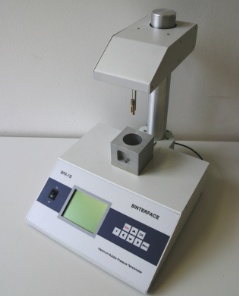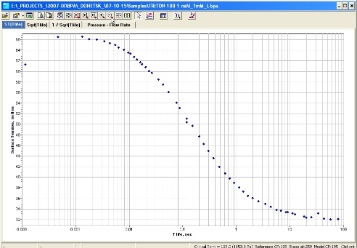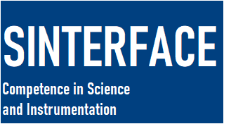Maximum Bubble Pressure Tensiometer BPA1S


· Many years the BPA-1S is representing the high end instrument of bubble pressure tensiometry.
· Many instrumental details have been published recently, such as the determination of bubble time characteristics from the gas flow signal. To reach the extra short times of milliseconds and less, the special measurement routine of Fainerman is applied.
· Can work as stand-alone, graphic display on board. Unique instrument for measurements down to 0.1 milliseconds.
Features
- direct and precise measurement of dead and life time
- surface tensions as function of physical time and adsorption time
- available time interval of 6 orders of magnitude (0.0001 to 100 s)
- precise measurement of scientific dynamic surface tensions
- direct determination of the hydrostatic pressure
- correction of effects from gravitation and viscosity of the liquid
- estimation of liquid’s viscosity
- temperature monitoring and control of the sample
- can be run also without PC
Main features of the software
BPA-1S can operate as stand-alone instrument. It stores data on board for 180 measurements which can be downloaded to a PC (Rs232 or USB via an adapter). The software allows graphical display of
several measurements for comparison. Graphics with various zoom functions supports the visual analysis of the data. Export as text file or directly into MS Excel. Unique instrument for very short adsorption times downto 0.1 milliseconds due to the application of the Fainerman measuring routine. Automatic and manual determination of the critical flow rate. Required small bubble volume and deadtime possible due to specially designed capillaries.
Technical Specifications
| Range of surface and interfacial tension | 10 to 150 mN/m |
| Resolution | ± 0.01 mN/m |
| Accuracy of surface tension measurement | better than 0.5% |
| Dynamic time range: | Standard capillary 10 ms to 30000 ms Special capillary 0.1 ms to 100000 ms |
| Display | Graphic display (b/w) resolution 320 x 240 pixel |
| Minimum volume test liquid | 1 ml |
| Temperature operating range | 10 – 50°C |
| Measurement temperature range | 0 – 100°C |
| Experimental time: Standard mode (M1) / Fast Mode (M4) |
20-30 min / 4-6 min |
| Software | Windows software (free update over 1 years after purchase) |
| Number of measurement point in one measurement: All scan modes (M1) Constant mode (M4) |
up to 180 up to 30000 |
| Operation mode | Stand-alone (built-in keyboard) or via PC |
| Data storing: Memory on board |
2 MB |
| Connectivity | RS-232 USB via an Adapter |
| Process control option | on baord (on request) |
| Dimensions (LxWxH) | 200 x 250 x 400 mm |
| Weight | 3 kg |
| Power requerment: | Measurement unit 12 VDC |
| Power supply, external | 100 … 240 AC; to 12 VDC |
| Max. power consumption | 6 W |
| Extra accessories | Capillaries of different diameters |
Measurement Examples
Dynamic Surface Tensions as Measured by the Maximum Bubble Pressure Analysers BPA1S / BPA2S
The simple portable maximum bubble pressure tensiometer BPA2P dynamic surface tensions can provide measuring data only in the time range between 10 ms and 10 s (three orders of magnitude). Dynamic surface tensions in a time interval from less than 1 ms up to about 100 s (almost six orders of magnitude) are available with our BPA1S and BPA2S. The instrument has quite a number of new features, such as direct determination of bubble time and dead time and respective calculation of the effective adsorption time, direct determination of the hydrostatic pressure via automatic immersion of the capillary into the liquid, and automatic correction of effects caused by gravitation and viscosity of the liquid. A comprehensive description of the bubble pressure methodology as well as the special details of our BPA-1S are described in a recently published book (V.B. Fainerman and R. Miller, Direct determination of protein and surfactant adsorption by drop and bubble profile tensiometry, in “Bubble and Drop Interfaces”, Vol. 2, Progress in Colloid and Interface Science, R. Miller and L. Liggieri (Eds.), Brill Publ., Leiden, 2011, p. 218-236; ISBN 978 90 04 17495 5).
The software of the BPA1S allows to display the results graphically via MS EXCEL, to which the data can be easily exported. The following graphics shows the time dependence of different surfactants studied by the BPA1S. In the first two examples it was demonstrated that bubble pressure tensiometry at sufficiently short adsorption times provides information on the micelle formation/dissolution dynamics (V.B. Fainerman, V.D. Mys, A.V. Makievski, J.T. Petkov and R. Miller, Dynamic surface tension of micellar solutions in the millisecond and sub‑millisecond time range, J. Colloid Interface Sci., 302 (2006) 40-46.), shown here for the non-ionic surfactants Triton X-45 (technical grade) and C14EO8 (a pure model surfactant).
The software of the BPA1S allows to display the results graphically via MS EXCEL, to which the data can be easily exported. The following graphics shows the time dependence of different surfactants studied by the BPA1S. In the first two examples it was demonstrated that bubble pressure tensiometry at sufficiently short adsorption times provides information on the micelle formation/dissolution dynamics (V.B. Fainerman, V.D. Mys, A.V. Makievski, J.T. Petkov and R. Miller, Dynamic surface tension of micellar solutions in the millisecond and sub‑millisecond time range, J. Colloid Interface Sci., 302 (2006) 40-46.), shown here for the non-ionic surfactants Triton X-45 (technical grade) and C14EO8 (a pure model surfactant).

Dynamic surface tension for Triton X‑45 solutions as a function of the effective surface lifetime. The surfactant concentrations are given as multiples of the CMC.

Dynamic surface tension for C14EO8 solutions as a function of the effective surface lifetime. The surfactant concentrations are given as multiples of the CMC
The third example shows the dynamic surface tensions of mixed solutions of SDS and C12EO5 at a mixing ratio of 30:1. The red curve shows the theoretical dependence for a pre-micellar solution, while the blue curves show the results of calculations using the theory for micellar solutions of the mixture.

Dynamic surface tension of mixed SDS/C12EO5 solutions for different molar ratio of components 30:1 and total solution concentration (top to bottom): 0.2 mmol/l (pre-micellar solution, CMC = 0.25 mmol/l); 0.5; 1.0 and 2.0 mmol/l.
In order to obtain a complete picture of the adsorption process, for the longer adsorption times (t>100 s) the PAT-1 was applied (V.B. Fainerman, E.V. Aksenenko, A.V. Mys, J.T. Petkov, J. Yorke and R. Miller, Adsorption layer characteristics of mixed SDS / CnEOm solutions. 3. Dynamics of adsorption and surface dilational rheology of micellar solutions, Langmuir,26 (2010) 2424-2429).
In order to obtain a complete picture of the adsorption process, for the longer adsorption times (t>100 s) the PAT-1 was applied (V.B. Fainerman, E.V. Aksenenko, A.V. Mys, J.T. Petkov, J. Yorke and R. Miller, Adsorption layer characteristics of mixed SDS / CnEOm solutions. 3. Dynamics of adsorption and surface dilational rheology of micellar solutions, Langmuir,26 (2010) 2424-2429).
Our service:
- selection of the right experimental technique for a given surfactant
- measurement of dynamic surface tensions over a respective adsorption time
- data analysis and graphical representation
- analysis of the adsorption mechanism
- proposal of other complementary techniques if needed
- compare with standard surfactants
- reference to literature data
- literature analysis to the subject


